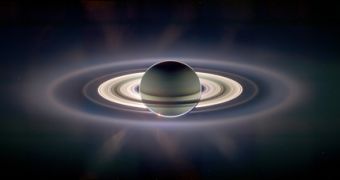Saturn is the second planet in size in the Sun System, with a diameter 10 times that of the Earth, but the gas giant is famous for its beautiful ring, whose origin remains an enigma. The ring comprises floating wide, flat discs of ice, varying in size from dust to over 10 ft (3 m) across.
Some believe they rooted in the same gas and dust that formed the planet, others think that the ring's icy chunks are pieces of moons resulted from collisions with asteroids or meteors.
A new research has detected inside the ring clusters of "moonlets," supporting the idea that big icy moons were slowly smashed to generate the ring system. The large ice pieces from the ring could only have been generated when something hit a body with a minimum size similar to that of Pan, Saturn's innermost moon, 15 mi (25 km) in diameter.
Odd, paired glowing lines within Saturn's outermost ring (the A ring) are located approximately 80,000 mi (130,000 km) off the planet's surface.
The streaks are similar to the propellers of airplanes and are generated when a bigger object (moonlets) moves through debris, like the wakes left by boats on the water.
"These moons are not massive enough to make too much havoc in the rings, but they are still big enough to create some disturbance. It's like a mini-moon inside of the ring." said co-author Miodrag Sremcevic, a postdoctoral researcher at the University of Colorado in Boulder.
The new research challenges the hypothesis that bigger pieces were generated by the joining of small ice chunks.
Sremcevic's team investigated pictures delivered by NASA's Cassini spacecraft in August 2005. 8 of the Saturn's A ring moonlets were crowded in a narrow belt, not randomly spread throughout the ring like they should have been, as predicted by the old theory. The moonlets have diameters of 160 to 500 ft (60 to 140 m).
"I really did not expect that. I was thinking these moonlets are everywhere, and with more patience and observation we would find them throughout the rings." Sremcevic said.
But rings appear to be very active, collisions smashing football-field-sized ice pieces and in time pieces get increasingly smaller, like sand forms from rocks on our planet.
"Some bigger moon was orbiting within the ring and was struck by a larger meteorite or comet. What we see today are remnants of that larger moon. The boulders may be useful as a sort of clock to chronicle the rings' history", said Sremcevic.
"Particles larger than about 30 feet (10 meters) tend to get ground down over time by meteorite impacts and interactions with other particles in rings. So it's possible that the larger the particle, the more recently it was formed, though this idea needs to be tested a lot more. A rough estimate for the timing of the collision that formed the eight moonlets is about a hundred million years ago." he added.
In 1984 one such event took place in Saturn's inner D ring: two 3-foot (1 m) objects collided.
"We actually came up with one hypothesis that could match up everything. That was: the rings were created a long time ago. That's an old idea. These moonlets are younger than the rest of the rings." said Sremcevic.

 14 DAY TRIAL //
14 DAY TRIAL //